100.1 Contents
UNIT 1 What is Life Made of? Chemistry, Cells, Energy

CHAPTER 1
Process of Science 1
Java Report
Making sense of the latest buzz in health-related news
1.1 Conflicting Conclusions 3
1.2 Science Is a Process: Narrowing Down the Possibilities 4
1.3 Anatomy of an Experiment 6
1.4 Sample Size Matters 7
1.5 Everyday Theory vs. Scientific Theory 8
1.6 Side Effects of Caffeine 10
1.7 Correlation Does Not Equal Causation 12
1.8 From the Lab to the Media: Lost in Translation 14
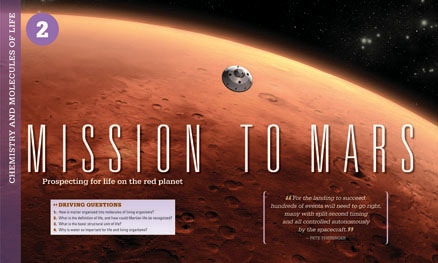
CHAPTER 2
Chemistry and Molecules of Life 20
Mission to Mars
Prospecting for life on the red planet
2.1 Five Functional Traits of Life 25
2.2 Touchdown, Gale Crater 26
2.3 All Matter Is Made of Elements 27
2.4 Carbon Is a Versatile Component of Life’s Molecules 29
UP CLOSE Molecules of Life: Carbohydrates, Proteins, Lipids, Nucleic Acids 30
2.5 A Layer Rich in Phospholipids Defines Cell Boundaries 33
2.6 Water Is Polar and Forms Hydrogen Bonds 34
2.7 Hydrogen Bonds Give Water Its Unique Properties 35
2.8 Water Is a Good Solvent 36
2.9 Solutions Have a Characteristic pH 37
2.10 On the Fringe 38
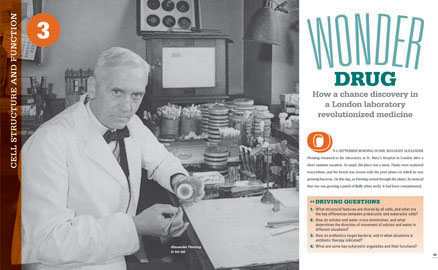
CHAPTER 3
Cell Structure and Function 44
Wonder Drug
How a chance discovery in a London laboratory revolutionized medicine
3.1 How Penicillin Was Discovered 46
3.2 Cell Theory: All Living Things Are Made of Cells 47
3.3 Prokaryotic and Eukaryotic Cells Have Different Structures 48
3.4 Water Flows across Cell Membranes by Osmosis 49
3.5 Some Antibiotics Inhibit Prokaryotic Ribosomes 52
3.6 Membranes: All Cells Have Them 53
3.7 Molecules Move across the Cell Membrane 55
3.8 Eukaryotic Cells Have Organelles 56
UP CLOSE Eukaryotic Organelles 58
M1 MILESTONES IN BIOLOGY
Scientific Rebel 66
Lynn Margulis and the theory of endosymbiosis
M1.1 Chloroplasts and Mitochondria Share Traits with Bacteria 69
M1.2 The First Eukaryotes Were Products of Endosymbiosis 70
xviii
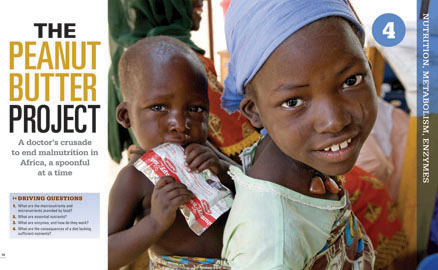
CHAPTER 4
Nutrition, Metabolism, enzymes 74
The Peanut Butter Project
A doctor’s crusade to end malnutrition in Africa, a spoonful at a time
4.1 Hunger around the World 77
4.2 Food Is a Source of Macronutrients 78
4.3 Macronutrients Build and Maintain Cells 79
4.4 Enzymes Facilitate Chemical Reactions 82
4.5 Enzymes Catalyze Reactions by Lowering Activation Energy 83
TABLE 4.1 A Sample of Micronutrients in Your Diet 85
4.6 Vitamins and Minerals Have Essential Functions 86
4.7 Peanut Butter-Based RUTF Saves More Children 88
4.8 A Balanced Diet 90
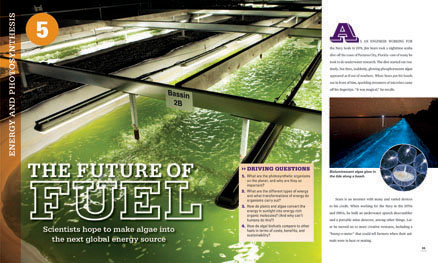
CHAPTER 5
Energy and Photosynthesis 94
The Future of Fuel
Scientists hope to make algae into the next global energy source
5.1 Distribution of Recoverable Oil Reserves 96
5.2 U.S. Energy Consumption 98
5.3 Algae Capture Energy in Their Molecules 99
5.4 Energy Is Conserved 100
5.5 Energy Conversion Is Not Efficient 101
5.6 Autotrophs Convert Light Energy into Chemical Energy 102
5.7 Photosynthesis Captures Sunlight to Make Food 103
5.8 The Energy in Sunlight Travels in Waves 106
5.9 Photosynthesis: A Closer Look 107
TABLE 5.1 How Green Are Biofuels? 108
 Americans burn through 378 million gallons of gasoline a day, enough to fill about 540 Olympic-size swimming pools
Americans burn through 378 million gallons of gasoline a day, enough to fill about 540 Olympic-size swimming pools .
.
— CHAPTER 5
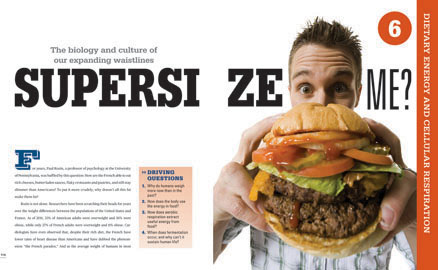
CHAPTER 6
Dietary Energy and Cellular Respiration 114
Supersize Me?
The biology and culture of our expanding waistlines
6.1 Obesity Is Influenced by Biology and Culture 116
6.2 Body Mass Index (BMI) 117
6.3 Americans Eat Large Portions 118
6.4 Food Powers Cellular Work 120
TABLE 6.1 Calories In, Calories Out 121
6.5 Glycogen and Fat Store Excess Calories 122
6.6 ATP: The Energy Currency of Cells 124
6.7 Aerobic Respiration Transfers Food Energy to ATP 125
6.8 Aerobic Respiration: A Closer Look 126
6.9 Fermentation Occurs When Oxygen Is Scarce 127
6.10 Photosynthesis and Aerobic Respiration Form a Cycle 129
xix
UNIT 2 How Does Life Perpetuate? Cell Division and Inheritance
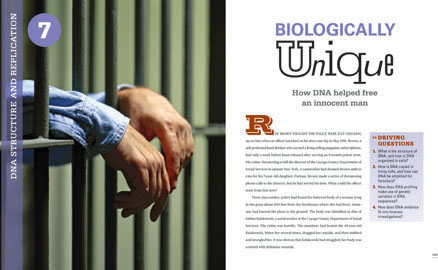
CHAPTER 7
DNA Structure and Replication 136
Biologically Unique
How DNA helped free an innocent man
7.1 What Is DNA, and Where Is It Found? 139
7.2 DNA Is Made of Two Strands of Nucleotides 140
7.3 DNA Structure Provides a Mechanism for DNA Replication 142
7.4 The Polymerase Chain Reaction Amplifies Small Amounts of DNA 144
7.5 DNA Profiling Uses Short Tandem Repeats 146
7.6 Creating a DNA Profile 147
7.7 DNA Profiling Uses Many Different STRs 148
M2 MILESTONES IN BIOLOGY
The Model Makers 154
Watson, Crick, and the structure of DNA
M2.1 The DNA Puzzle 156
M2.2 Rosalind Franklin and the Shape of DNA 157
M2.3 Erwin Chargaff’s Work Provided a Clue to Base Pairing 158
M2.4 The Structure Is Finally Known: The DNA Double Helix 159
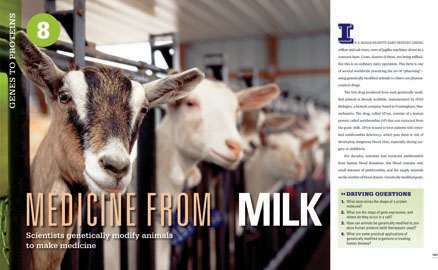
CHAPTER 8
Genes to Proteins 162
Medicine from Milk
Scientists genetically modify animals to make medicine
8.1 Amino Acid Sequence Determines Protein Shape and Function 165
8.2 Chromosomes Include Gene Sequences That Code for Proteins 166
8.3 Antithrombin Deficiency Can Cause Blood Clots 167
8.4 Genes to Proteins: Different Alleles Influence Protein Function 168
8.5 The Two Parts of a Gene 169
8.6 Making a Transgenic Goat 171
8.7 Gene Expression: An Overview 173
8.8 Transcription: A Closer Look 174
8.9 Translation: A Closer Look 175
8.10 The Genetic Code Is Universal 176
M3 MILESTONES IN BIOLOGY
Sequence Sprint 182
Venter and Collins race to decode the human genome
M3.1 DNA Sequencing: Hierarchical Shotgun Method 184
M3.2 DNA Sequencing: Whole-Genome Shotgun Method 186
M3.3 New Technology Cut DNA Sequencing Time and Cost 187
M3.4 Linking Genes to Disease 190
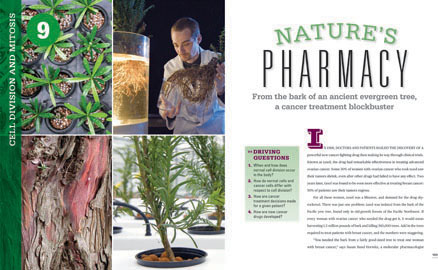
CHAPTER 9
Cell Division and Mitosis 192
Nature’s Pharmacy
From the bark of an ancient evergreen tree, a cancer treatment blockbuster
9.1 Why Do Cells Divide? 195
9.2 The Cell Cycle: How Cells Reproduce 196
TABLE 9.1 Drugs from Plants 198
UP CLOSE Cell Cycle and Mitosis 200
9.3 Taxol Interferes with Mitosis 202
9.4 Cell Division Is Tightly Regulated 203
9.5 Cancer: When Checkpoints Fail 204
9.6 Taxol Prolongs Survival in Cancer Patients 207
xx
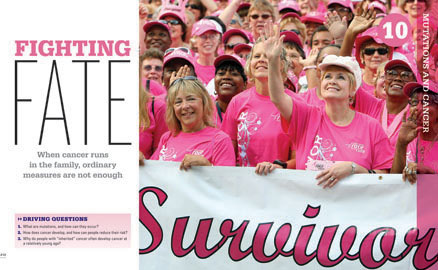
CHAPTER 10
Mutations and Cancer 212
Fighting Fate
When cancer runs in the family, ordinary measures are not enough
10.1 Mutations in the BRCA1 Gene Increase the Risk of Cancer 215
10.2 Replication Errors and Other DNA Damage Can Produce New Alleles 216
10.3 Mutations Can Be Hereditary or Nonhereditary 217
TABLE 10.1 Incidence of Hereditary Diseases in Different Populations 218
10.4 Mutations in DNA Can Alter Protein Function and Cause Cancer 219
10.5 What Causes Mutations? 220
10.6 Mutations in Two Types of Cell Cycle Genes Cause Most Types of Cancer 221
10.7 Tumors Develop in Stages as Mutations Accumulate in a Cell 222
10.8 BRCA Mutations Increase the Risk of Breast and Ovarian Cancer 223
TABLE 10.2 Reducing the Risk of Cancer 224
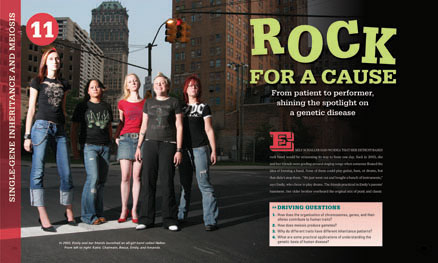
CHAPTER 11
Single-Gene Inheritance and Meiosis 228
Rock for a Cause
From patient to performer, shining the spotlight on a genetic disease
11.1 CF Is Caused by Mutations in the CFTR Gene 230
11.2 Humans Have Two Copies of Nearly Every Gene 232
11.3 Gametes Pass Genetic Information to the Next Generation 233
11.4 Meiosis Produces Haploid Egg and Sperm 234
11.5 Meiosis Produces Genetically Diverse Egg and Sperm 235
11.6 The CFTR Protein and Cystic Fibrosis 236
11.7 How Recessive Traits Are Inherited 238
11.8 How Dominant Traits Are Inherited 239
TABLE 11.1 Inherited Genetic Conditions in Humans 240
11.9 Tracking the Inheritance of Two Genes 241
Mendel provided a new explanation for heredity, decades before the word “genetics” was coined.
— MILESTONE 4
M4 MILESTONES IN BIOLOGY
Mendel’s Garden 248
An Austrian monk lays the foundation for modern genetics
M4.1 Theories of Inheritance before Mendel 250
M4.2 Mendel’s Experiments 252
M4.3 Mendel’s Law of Segregation 253
M4.4 Mendel’s Law of Independent Assortment 254
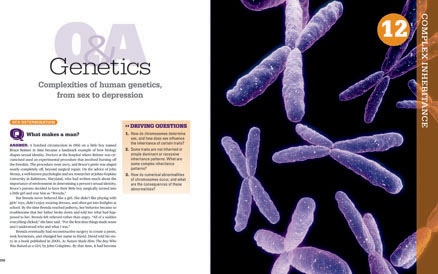
CHAPTER 12
Complex Inheritance 256
Q&A: Genetics
Complexities of human genetics, from sex to depression
12.1 X and Y Chromosomes Determine Human Sex 258
TABLE 12.1 Between Male and Female: Varieties of Sex and Intersex 260
12.2 X-Linked Traits Are Inherited on X Chromosomes 261
12.3 Female Carriers Can Pass Disease Alleles to Their Children 262
xxi
12.4 Y Chromosomes Pass Largely Unchanged from Fathers to Sons 264
12.5 DNA Links Sally Hemings’s Son to Jefferson 265
12.6 Hair Texture Exhibits Incomplete Dominance 268
12.7 Human Blood Type Is a Codominant Trait 269
12.8 A Mismatched Blood Transfusion Causes Immune Rejection 270
12.9 Human Height Is Both Polygenic and Multifactorial 272
12.10 Serotonin Transporter Function Is Linked to Depression 273
12.11 Depression Is a Multifactorial Trait 274
12.12 Chromosomal Abnormalities: Aneuploidy 276
12.13 Amniocentesis Provides a Fetal Karyotype 277
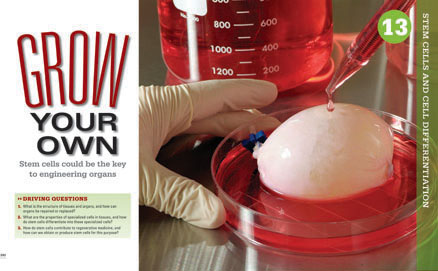
CHAPTER 13
Stem Cells and Cell Differentiation 282
Grow Your Own
Stem cells could be the key to engineering organs
13.1 Stem Cells in Tissues Have Regenerative Properties 285
13.2 Cells Are Organized into Tissues, Organs, and Systems 286
13.3 Engineering an Organ Using Stem Cells 286
TABLE 13.1 How Old Are You? 288
13.4 Specialized Cells Express Different Genes 289
13.5 Regenerative Medicine: Four Approaches 290
13.6 Embryonic vs. Adult Stem Cells 292
13.7 Somatic Cell Nuclear Transfer Produces Cloned Embryonic Stem Cells 294
13.8 Induced Stem Cells 295
UNIT 3 How Does Life Change over Time? Evolution and Diversity
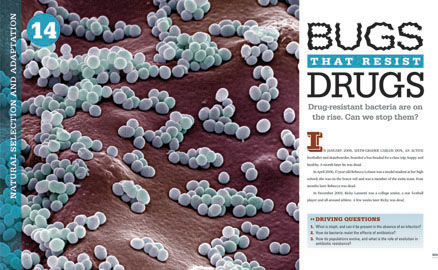
CHAPTER 14
Natural Selection and Adaptation 302
Bugs That Resist Drugs
Drug-resistant bacteria are on the rise. Can we stop them?
14.1 The Bacterium Staphylococcus aureus 305
14.2 How Beta-Lactam Antibiotics Work 307
14.3 How Bacteria Reproduce 308
14.4 How Bacterial Populations Acquire Genetic Variation 309
14.5 An Organism’s Fitness Depends on Its Environment 310
14.6 Evolution by Natural Selection 311
14.7 Patterns of Natural Selection 312
14.8 Preventing and Treating Infection by Antibiotic-Resistant Bacteria 315
M5 MILESTONES IN BIOLOGY
Adventures in Evolution 320
Charles Darwin and Alfred Russel Wallace on the trail of natural selection
M5.1 Lamarckianism: An Early Idea about Evolution 323
M5.2 Darwin’s Voyage on the Beagle 324
M5.3 The Evolution of Darwin’s Thought 326
M5.4 The Evolution of Wallace’s Thought 328
Scientists are now seeing bacterial infections that don’t respond to any known antibiotics, leading many to fear the day when we run out of treatment options altogether.
— CHAPTER 14
xxii
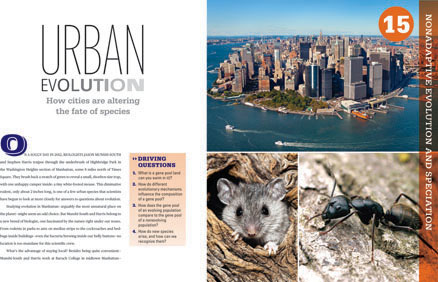
CHAPTER 15
Nonadaptive Evolution and Speciation 330
Urban Evolution
How cities are altering the fate of species
15.1 Population Genetics 333
15.2 Gene Pools of New York City Mouse Populations 335
15.3 Genetic Drift Reduces Genetic Diversity 336
15.4 Gene Flow Increases Genetic Diversity in Populations 338
15.5 City Mouse and Country Mouse 340
TABLE 15.1 Adaptive and Nonadaptive Mechanisms of Evolution 341
UP CLOSE Calculating the Hardy-Weinberg Equilibrium 342
15.6 Species Are Reproductively Isolated 346
15.7 Speciation: How One Species Can Become Many 347
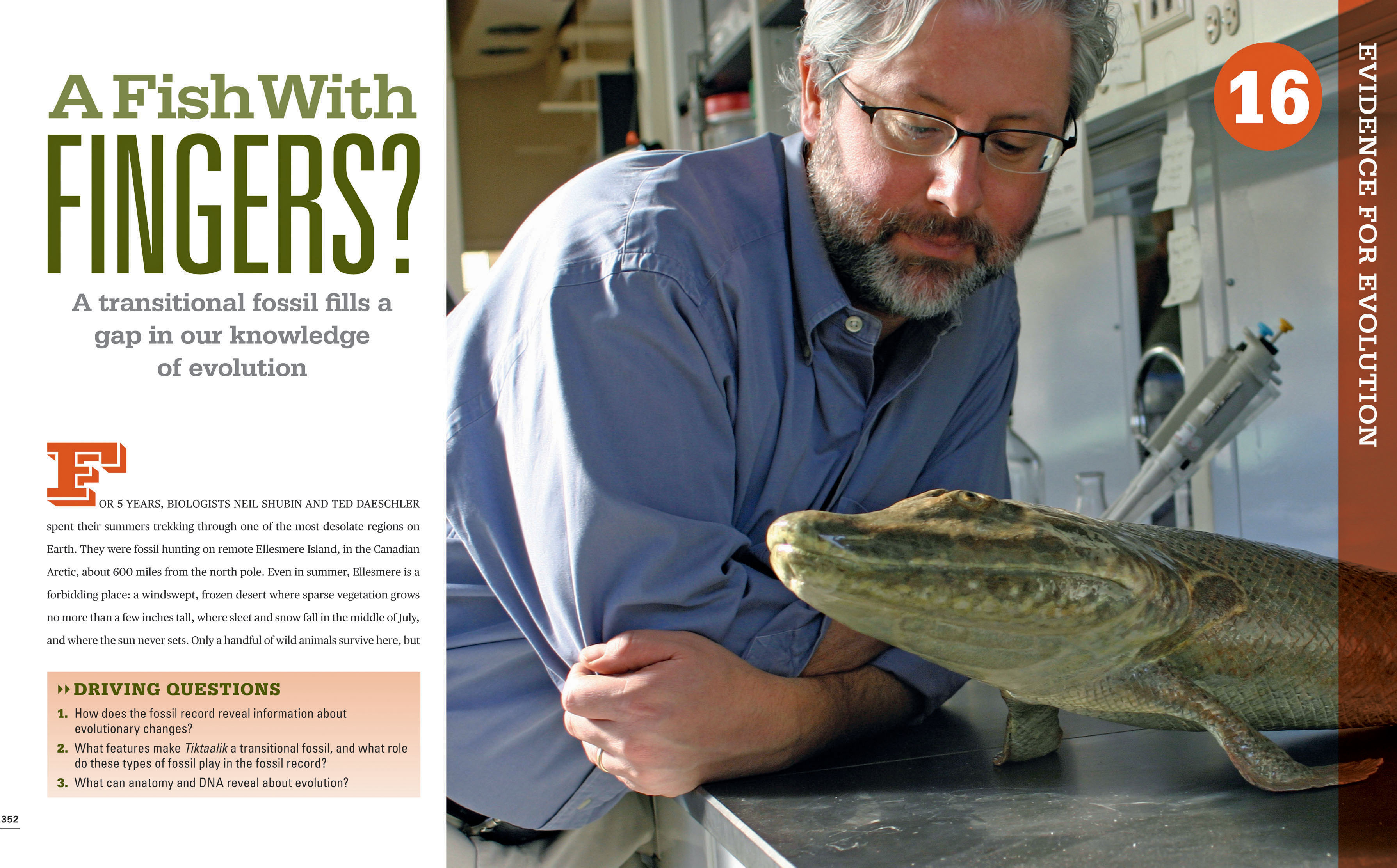
CHAPTER 16
Evidence for Evolution 352
A Fish with Fingers?
A transitional fossil fills a gap in our knowledge of evolution
16.1 Fossils Form Only in Certain Circumstances 356
16.2 Fossils Reveal Changes in Species over Time 357
16.3 How Fossils Are Dated 359
16.4 Tiktaalik, an Intermediate Fossilized Organism 363
16.5 Forelimb Homology in Fish and Tetrapods 364
16.6 Vertebrate Animals Share a Similar Pattern of Early Development 365
16.7 Related Organisms Share DNA Sequences 367
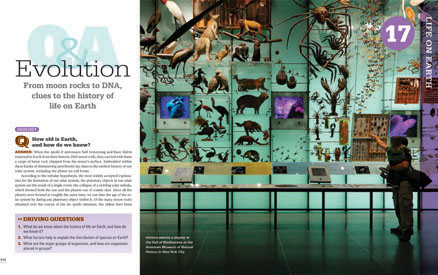
CHAPTER 17
Life on Earth 372
Q&A: Evolution
From moon rocks to DNA, clues to the history of life on Earth
17.1 Unstable Elements Undergo Radioactive Decay 375
17.2 Radioactive Decay Is Used to Date Some Rock Types 376
17.3 Geologic Timeline of Life on Earth 378
17.4 Movement of Earth’s Plates Influences Climate and Biogeography 380
17.5 How Many Species Are There? 382
17.6 Classification of Species 383
17.7 How to Read a Phylogenetic Tree 384
17.8 Genetics Defines Three Domains of Life: Bacteria, Archaea, Eukarya 386
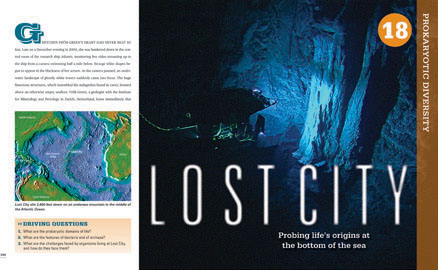
CHAPTER 18
Prokaryotic Diversity 390
Lost City
Probing life’s origins at the bottom of the sea
18.1 Hydrothermal Vents of Lost City Provide an Extreme Environment for Life 392
18.2 Investigating Life in Lost City 394
18.3 Prokaryotic Cells Are Small and Lack Organelles 396
18.4 Prokaryotes Are Abundant and Diverse 397
18.5 Bacteria and Archaea, Life’s Prokaryotic Domains 398
18.6 Exploring Bacterial Diversity 400
18.7 Exploring Archaeal Diversity 402
18.8 Energy from the Earth Fuels Life at Lost City 404
xxiii
 “[Lost City] is a good example of what we really don’t know and what there is to still discover on the seafloor.”
“[Lost City] is a good example of what we really don’t know and what there is to still discover on the seafloor.”
— GRETCHEN FRÜH-GREEN, CHAPTER 18
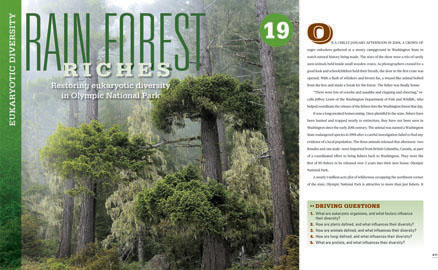
CHAPTER 19
Eukaryotic Diversity 410
Rain Forest Riches
Restoring eukaryotic diversity in Olympic National Park
19.1 Tree of Life: Domain Eukarya 412
19.2 The Landscape of Olympic National Park 413
19.3 Evolution of Plant Diversity 414
19.4 Evolution of Animal Diversity 417
19.5 Fungi, the Decomposers 422
19.6 The Challenge of Classifying Protists 423
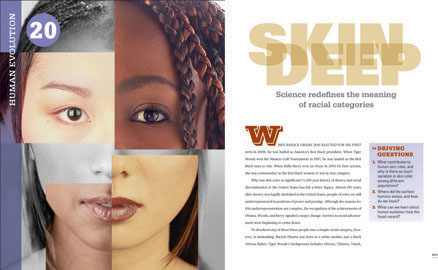
CHAPTER 20
Human Evolution 430
Skin Deep
Science redefines the meaning of racial categories
20.1 Humans Are Genetically Similar 432
20.2 Melanin Influences Skin Color 433
20.3 Folate and Vitamin D Are Necessary for Reproductive Health 435
20.4 Human Skin Color Correlates with UV Light Intensity 436
20.5 Mitochondrial DNA Is Inherited from Mothers 437
20.6 Modern Human Populations Share a Common Female Ancestor 438
20.7 Out of Africa: Human Migration 439
20.8 Traits of Modern Humans Reflect Evolutionary History 440
20.9 Natural Selection Influences Human Evolution 442
20.10 The Evolution of Skin Color 444
UNIT 4 What Makes Up Our Environment? Ecology
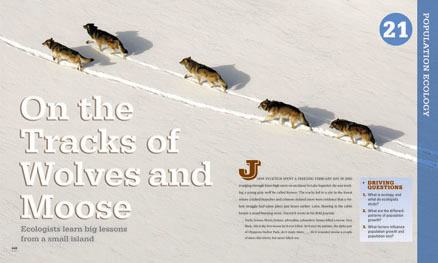
CHAPTER 21
Population Ecology 448
On the Tracks of Wolves and Moose
Ecologists learn big lessons from a small island
21.1 Ecology of Isle Royale 451
21.2 Distribution Patterns Influence Population Sampling Methods 452
21.3 Population Distribution Patterns 453
21.4 Population Growth and Carrying Capacity 455
21.5 Population Cycles of Predator and Prey 456
21.6 Patterns of Population Growth 457
21.7 Moose and Wolf Health Is Monitored by a Variety of Data 458
21.8 Abiotic and Biotic Influences on Population Growth 459
21.9 A Warming Climate Influences Moose and Wolf Population Size 462
xxiv
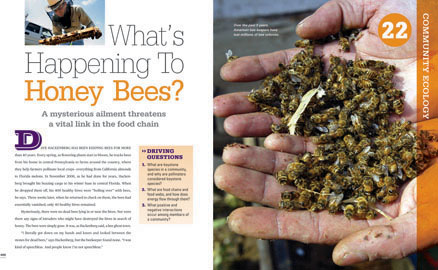
CHAPTER 22
Community Ecology 466
What’s Happening to Honey Bees?
A mysterious ailment threatens a vital link in the food chain
22.1 Bees Are Keystone Species 468
22.2 Commercial Crops Require Bees 469
22.3 Flowering Plant Reproduction Relies on Pollinators 470
22.4 Energy Flows up a Food Chain 472
22.5 A Honey Bee Food Web 473
22.6 Organisms May Live Together in Symbioses 474
22.7 Pollinators Have Different Ecological Niches 476
22.8 Bees Compete for Resources 477
22.9 What Is Causing Colony Collapse Disorder? 480
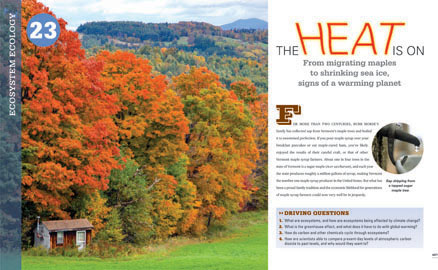
CHAPTER 23
Ecosystem Ecology 486
The Heat Is On
From migrating maples to shrinking sea ice, signs of a warming planet
23.1 U.S. Maple Syrup: A Thing of the Past? 488
23.2 Rising Temperatures Affect Plant Behavior 489
23.3 Maple Tree Range Is Affected by Rising Temperatures 491
UP CLOSE Biomes 492
23.4 The Greenhouse Effect 493
23.5 Earth’s Surface Temperature Is Rising with Increases in Greenhouse Gases like Carbon Dioxide 494
23.6 Rising Temperatures Mean Widespread Ecosystem Change 495
23.7 Arctic Temperatures Are Rising Fast 497
23.8 Arctic Sea Ice Is Melting 498
23.9 The Carbon Cycle 499
UP CLOSE Chemical Cycles 500
23.10 Measuring Atmospheric Carbon Dioxide Levels 502
23.11 Anthropogenic Production of Greenhouse Gases 503
M6 MILESTONES IN BIOLOGY
Progress or Poison? 510
Rachel Carson, pesticides, and the birth of the environmental movement
M6.1 Widespread Use of DDT to Kill Mosquitoes and Lice 513
M6.2 Unintended Consequences of Using DDT 514
M6.3 Biomagnification 515

“In its simplest sense, sustainability is just doing things today to ensure a vibrant successful future for others.”
— STACEY SWEARINGEN WHITE, CHAPTER 24
CHAPTER 24
Sustainability 520
The Makings of a Green City
One Kansas town reinvents itself sustainable
24.1 The Human Ecological Footprint 524
xxv
24.2 The Human Ecological Footprint Is Greater than Earth’s Biocapacity 526
24.3 Countries Differ in Their Ecological Footprint 527
24.4 Fossil Fuels Are Nonrenewable 528
24.5 Human Population Growth 532
24.6 Species Loss Increases as Human Population Grows 534
24.7 Nonfossil Fuel Resources Reduce Our Ecological Footprint 536
24.8 Water Is a Renewable Resource 537
24.9 Depletion of Freshwater by a Growing Population 539
24.10 Water Availability Is Not Equally Distributed 540
24.11 What You Can Do to Live More Sustainably 541
Answers 546
Glossary 555
Photo Credits 564
Index 569